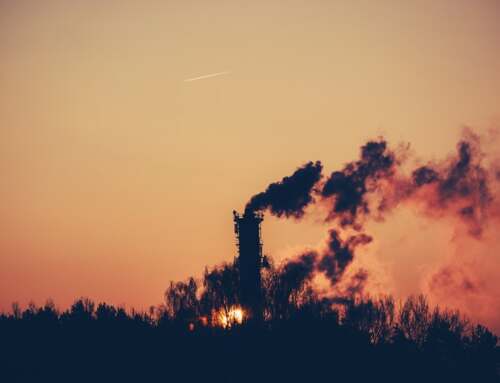Air quality implications of processing meat and other animal products
 Pinpointing the cause of poor air quality can be difficult at times – leading to unnecessarily prolonged exposure to hazardous pollutants for workers, neighbours and the environment. In this expert series, we take a closer look at specific industries and some of the more common contaminants that could affect the air in your workplace or home, as well as treatment strategies to deal with it.
Pinpointing the cause of poor air quality can be difficult at times – leading to unnecessarily prolonged exposure to hazardous pollutants for workers, neighbours and the environment. In this expert series, we take a closer look at specific industries and some of the more common contaminants that could affect the air in your workplace or home, as well as treatment strategies to deal with it.
The number of products that human society generates from other animals is astounding. Dairy, meat, eggs, leather, wool… the list goes on. Not only is the livestock farming industry massive, but there are many specialist industries aiming to ensure that no part of the animals goes to waste when they die.
This part of our series is a double feature, focussing on two such industries related by the common theme of processing animal components into consumer products. Abattoirs (informally known as slaughterhouses) present an efficient method to produce meat from the carcasses of livestock, while Protein Recovery Plants (informally known as rendering plants) are designed to produce other by-products. The two facilities are often located near each other (perhaps combined in an integrated meat processing plant) and may share similar compounds that affect air quality.
Abattoirs: From farm to plate
The general method for processing livestock into meat for human consumption is one that requires strict adhesion to both hygienic, ethical and even religious guidelines. Unclean operations such as stunning, bleeding and defeathering/dehairing/dehiding are kept separate from the clean operations such as evisceration and carcass splitting and dressing. This helps avoid contamination between edible and inedible products (Food and Agriculture Organization of the United Nations, 2014). These strict hygiene practices assist in minimising air pollution, although some sources of foul air remain in most facilities.
Animal arrival and lairage
First, live animals must be delivered to the facility. Vehicles are washed to avoid the stagnation of any manure that may remain after the transport. This reduces gaseous manure emissions such as methane (CH4), nitrous oxide (N2O) and ammonia (NH3) (Sejan, et al., 2015). But traffic-related exhaust emissions like nitrogen oxides (NOx, NO2), carbon monoxide (CO) and particulate matter (PM2.5) also should not be overlooked. These compounds occur from vehicle movements of loading and unloading animals and produce. Upgrading delivery fleet vehicles that use low pollutant fuels would be an excellent step forward in reducing unexpected atmospheric emissions.
If arriving animals are held for some time, the pens must be maintained to an acceptable standard. Organic particulate matter can be released by the movement of so many bodies and subsequently inhaled by workers or blown off-site by the wind to impact the community. For a related glimpse into the interesting air quality issues that can affect the environments of intensive livestock farming, see Part III of this series.
Slaughter
The animals are then corralled into the slaughter floor, which is kept cold and clean. Surprisingly, there are few air emission control measures here besides adequate ventilation, as with correct management of the facility, they are not needed in this area of the abattoir. Most odorous compounds are emitted from organic by-products of the meat processing, however these are segregated and transported to different locations quickly.
The blood drained from carcasses is collected and flushed into wastewater tanks before it can stagnate and allow bacteria to form (Bah, Bekhit, Carne, & McConnell, 2013). Since so many animals are processed at plants every day, there is a massive volume of liquid waste that also needs appropriate treatment. This wastewater is highly odorous due to the increased level of organic matter content, typically referred to and measured in terms of the wastewater’s biological oxygen demand (BOD).
Many abattoirs have immediate treatment facilities on-site to avoid allowing blood-soaked wastewater to become more odorous with time. These facilities are also likely sources of gas emissions as we mentioned in Part I of this series. Wastewater is often used for irrigation purposes, but if the wastewater from slaughterhouses is not properly treated, then this can lead to irrigating with odorous effluent and cause further contamination of the environment and a significant odour problem. A combination of physical, chemical and biological treatment processes is recommended in order to reuse abattoir wastewater. For a detailed review see (Bustillo-Lecompte & Mehrvar, 2017).
Other products of the slaughtering process must also be properly managed. Animal skins are collected in bins and treated with brine or salt before being transported off-site to tanneries and woolscours. This helps to preserve them for the journey and limit gasses that would otherwise be emitted if left to decompose.
Paunch, the odorous fermenting half-digested contents of cow stomachs, is often composted on-site. If poorly managed however, the composting process may be the cause of increased odour at the abattoir. Care must be taken to follow appropriate guidelines for composting paunch by composting it with other carbon rich materials and monitoring the carbon to nutrient ratio throughout the process (Environmental Protection Authority, 2017).
If treated correctly, paunch can then be transported off-site for beneficial reuse as fertiliser agent. Some studies suggest that it could be dried out and used as an energy source to supplement coal burning and reduce total coal consumption (Australian Meat Processor Corporation, 2017).
Often, air supplies between sections of the plant are also kept isolated in order to more efficiently treat the more odorous emissions (holding and wastewater tanks) with scrubbers and biofiltration. The whole process is designed to minimise the contamination of meat that will be presented to consumers.
Storage
After being butchered, with inedible products such as fat removed, the carcasses are kept in a cold storage facility. No emissions of odour or dust are generally expected from this part of the facility, since the meats are kept free of airborne diseases and contaminants through hygienic practises. Bioaerosols are minimised by the low temperature and frequent cleaning.
It is important to remember that cold rooms have a designated capacity. Scheduling of delivery activities both to and from the abattoir must run like clockwork. Proper management helps to stop incoming animals from standing in crowded conditions, trucks idling and emitting fumes, and refrigerated meat products from spoiling.
Rendering: Cook what cannot be eaten
Around 50 per cent of livestock weight are the by-products not stored for human consumption (Guerra, Smith Jr., Alexis, & Whitehead, 2017). These must be disposed of or, ideally, transformed into a more useful product. Rendering plants recycle and cook the leftover animal matter from abattoirs (and occasionally other facilities) with either steam or within a steam-jacketed vessel.
Fat, trimmings, entrails, blood, bone, feathers and cartilage are all mixed and rendered at high temperatures and pressures to separate protein from fat. This creates nutritious protein meal, for mixing with fertilisers and animal feeds, and tallow (Meeker & Hamilton, 2006) (Walsh, 1967). Tallow is used in many applications, but it is commonly known as an ingredient for candles and soap.
Nuisance odours
The main air quality issue facing rendering plants involves the malodourous gasses that are emitted during the rendering processes. Volatile organic compounds (VOCs) are likely to be emitted from the boilers used to produce the steam necessary for operation. Other common gasses created throughout the plant include volatile fatty acids (VFAs) {i.e. acetic acid, propionic acid, butanoic acid}, hydrogen sulfide (H2S), mercaptans and ammonia (NH3) (Anet, et al., 2013) (Guerra, Smith Jr., Alexis, & Whitehead, 2017).
Interestingly, each of the individual concentrations of these compounds are often at the parts per billion scale, but this is enough to cause distress to workers and anyone else close to the plant. This is especially true if there are gas leaks in the rendering process, where intense and unpleasant odours can permeate the plant.

A schematic of the processes involved in a rendering plant including odour control (Anet, et al., 2013)
To avoid these nuisance compounds, complex odour control systems are utilised (see the above figure – Anet, et al., 2013). The odours produced by the high-pressure cooking of animal by-products are intimately mixed with steam. This makes isolating and neutralising the compounds difficult. Once the cooking is finished, the batch cookers must be cleaned, and the steam must be treated to control odorous emissions.
One method for odour control is incineration of the vapour, which destroys the odorous compounds. However, it is inefficient to dispose of such a large quantity of steam mixed with relatively small concentrations of malodourous gasses. Instead, a more commonly recommended technique for odour control in rendering facilities is to recondense the steam.
This liquid is then sent to wastewater treatment plants for processing. The remaining ‘non-condensable’ gasses are biologically filtered or chemically scrubbed in order to remove the malodour and reduce the emissions to more breathable levels. Biofilters are commonly used for this purpose, reducing the air emissions to an earthy, soil-like odour character. Most rendering plants use a combination of many different techniques, in order to drop the large odour concentrations to manageable levels.
Dust and other air pollutants
Another cause for air quality concern is the dust created with the dehydrated animal meal. This powdery, very dry protein is an excellent source of nutrients, but care must be taken to minimise the particulate matter that may be displaced when unloading or moving the meal. Workers should wear appropriate personal protective equipment and it is recommended to use air pollution control devices such as cyclone dust collectors. Plants should also be designed in such a way to minimise the surface area and exposure time of product to the atmosphere (Australian Meat Processor Corporation, 2006).
Last, but not least, boilers, typically fired on natural gas, are another source of hazardous air pollutants. Used to heat water for abattoir cleaning and steam production for cooking waste material in the rendering plant, boilers emit important pollutants such as nitrogen oxides, carbon monoxide, PM2.5 and VOCs. Such emissions are typically well dispersed through a chimney stack but also need to be considered as part of an impact assessment of the facility or site environmental management plan.
Food for thought
In 2018, an estimated 72 billion animals (only counting chickens, pigs, turkeys, goats, sheep and cattle) were slaughtered for meat globally (Ritchie & Roser, 2019). Although meat alternatives are growing in popularity, this staggering amount of animal matter must still be processed in an efficient and sustainable way. Abattoirs bolster efficiency by meeting the ever-growing demand for global meat consumption, while rendering plants are one of the most sustainable disposal and recycling facilities for this kind of organic waste (Gooding & Meeker, 2016).
It is critical that these industries do not unknowingly hinder their contribution to society by polluting the surrounding atmosphere with air pollutants, nuisance odours or greenhouse gases.
Since the industries are so closely linked, both abattoirs and rendering plants can work together to further innovate on processing technologies and methods. When producing anything, one must always remember that there will be by-products of some kind – be they something recyclable such as tallow, or something invisible like odour. Communication with industries related to your own is one necessity to minimising the environmental impact of any waste.
References and Further Reading
Anet, B., Lemasle, M., Couriol, C., Lendormi, T., Amrane, A., Le Cloirec, P., . . . Fillieres, R. (2013). Characterization of gaseous odorous emissions from a rendering plant by GC/MS and treatment by biofiltration. Journal of Environmental Management, 981-987.
Australian Meat Processor Corporation. (2006). Meat Technology Information Sheet – Environmental Control in the Rendering Industry. Retrieved from Australia Meat Processor Corporation: https://www.ampc.com.au/uploads/cgblog/id140/ENV_2006_Environmental-control-in-the-rendering-industry—1997.pdf
Australian Meat Processor Corporation. (2017). Final Report – Organic waste management at abattoirs. Sydney: AMPC.
Bah, C. S., Bekhit, A. E.-D., Carne, A., & McConnell, M. A. (2013). Slaughterhouse Blood; An Emerging Source of Bioactive Compounds. Comprehensive Reviews in Food Science and Food Safety, 314-331.
Bustillo-Lecompte, C., & Mehrvar, M. (2017). Slaughterhouse Wastewater: Treatment, Management and Resource Recovery. In R. Farooq, & Z. Ahmad, Physico-Chemical Wastewater Treatment and Resource Recovery (pp. 153-174). Intech.
Environmental Protection Authority. (2017). Paunch Contents Land Spreading Management Guidelines. Hobart: EPA.
Food and Agriculture Organization of the United Nations. (2014, November 25). Slaughtering Facilities. Retrieved from Animal Production and Health: http://www.fao.org/ag/againfo/themes/en/meat/slaughtering.html.
Gooding, C. H., & Meeker, D. L. (2016). Review: Comparison of 3 alternatives for large-scale processing of animal carcasses and meat by-products. The Professional Animal Scientist, 259-270.
Guerra, F. D., Smith Jr., G. D., Alexis, F., & Whitehead, D. C. (2017). A Survey of VOC Emissions from Rendering Plants. Aerosol and Air Quality Research, 209-217.
Meeker, D., & Hamilton, C. R. (2006). An overview of the rendering industry. Essential Rendering: All about the Animal By-products Industry, 1-16.
Ritchie, H., & Roser, M. (2019, November 1). Meat and Dairy Production. Retrieved from Our World in Data: https://ourworldindata.org/meat-production.
Sejan, V., Samal, L., Bagath, M., Suganthi, R., Bahatta, R., & Lal, R. (2015). Gaseous Emissions from Manure Management. In R. Lal, Encyclopedia of Soil Science. Taylor and Francis.
Walsh, R. T. (1967). Air Pollution Aspects of the Inedible Rendering Industry. Journal of the Air Pollution Control Association, 94-97.











